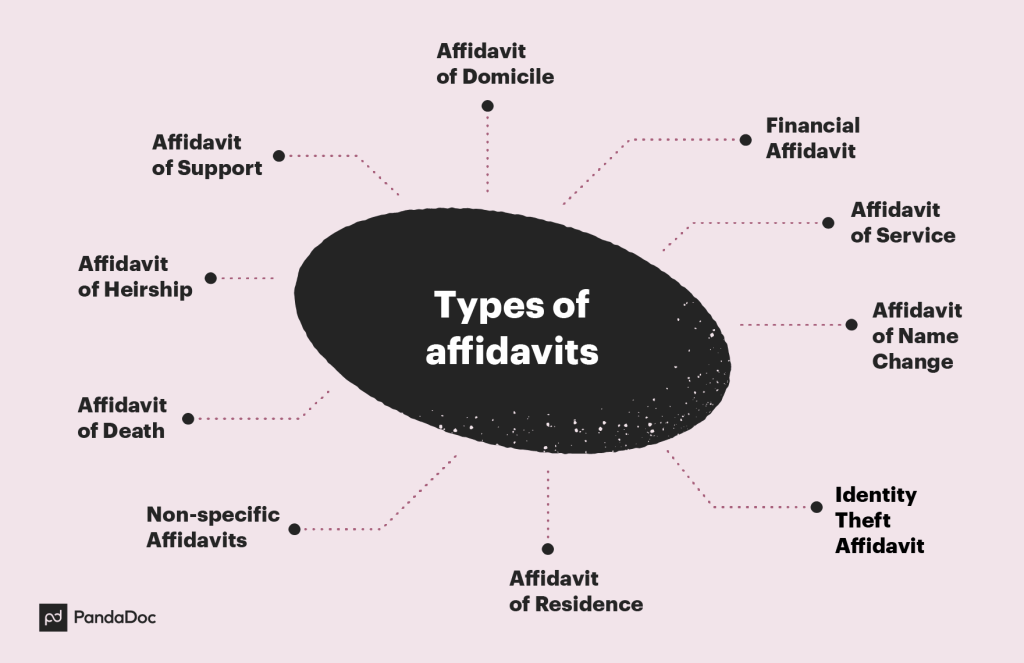If you’ve ever been involved in an important court proceeding, you know what an affidavit is. If not, you may be intimidated by the process of developing and finalizing one.
However, affidavits are important and there are times when you might find you need one. When that time comes, it’s helpful to have some information that demystifies the process.
To help, we’re defining what an affidavit is and why they matter.
What exactly is an affidavit?
An affidavit is a written testimony intended to show a court or other agency that specific information is truthful.
These legal documents have become the standard when an authority (think judge, government agency, or insurance agency) needs to verify the information they’re receiving is accurate.
Affidavits come into play when someone is unable to appear to court in person. When someone provides testimony before a judge in person, they are under oath – meaning they cannot lie.
If they do lie, they’ll face punishments for committing what’s known as perjury. However, if someone cannot come to the courthouse, they can instead file an affidavit. The affidavit will hold the person to the same standards as if they were actually under oath in front of the judge.
Beyond the courthouse, affidavits are useful for personal or business transactions. For instance, you’ll likely need to create and sign an affidavit if you are transferring legal rights to a power of attorney.
You’ll also need to file an affidavit for a loved one if they pass away in order to validate they are deceased. In addition, you’ll need to provide some sort of affidavit reflecting the accuracy of your financial status when applying for loans with the bank.
For business transactions, affidavits can confirm a future partner or investor is telling the truth about their financial abilities. This is a general due diligence step that every business needs to take before joining forces with a new partner or investor.
So, what all does drafting an affidavit entail? It’s not as difficult to understand as you may think, but there are a number of important details that you’ll need to be aware of.
What’s included in an affidavit?
Affidavits contain a number of components, all of which are similar regardless of the situation that an affidavit is used for.
Below are a few key terms you’ll find in any affidavit and what they mean.
1. Affiant
The affiant is the person who needs to demonstrate factual evidence. This is the same person who will sign the affidavit.
For example, a person who needs to prove their financial status would be the affiant in a Financial Affidavit. When drafting your affidavit, you should clearly list the affiant’s print name and signature block.
2. Affirmation
Here’s where the substance of the affidavit can be found. The affirmation section dutifully lists all events, facts, and details that need to be verified. You’ll want to make sure the affirmation section is easy to follow.
If you need to list several details that make the affirmation difficult to read, consider putting some details in the attachments section.
3. Witnesses
The witness (or witnesses) are the individuals who were present when the affiant signed the affidavit. This could be a notary of the public or another neutral third party.
Be sure to review your state and local laws to ensure a notary can serve as a witness on your affidavit.
4. Penalty of Perjury
This section outlines the penalties the affiant may face for misrepresenting the facts in the affirmation section. The penalty section is necessary so the affiant understands the potential punishments for falsifying the affidavit.
Remember to only provide facts in the affirmation section to avoid penalties such as fines and even arrests.
5. Notary Public Certification
This section is intended to be left blank until you find a notary. A notary public is an official who is appointed by the Secretary of State as an impartial witness.
Notaries are in charge of deterring fraud when individuals sign important legal documents. Affidavits must be authenticated by a notary to be properly executed.
6. Attachments
At the end of your affidavit, you’ll include attachments that provide details on the affirmations section. Generally, the attachments can be any document that helps support the facts you already provided.
The type of attachment you include will depend on the type of affidavit you’re looking to file.
For Financial Affidavits, which prove your financial health, you may include bank statements, tax returns, or other financial reports as attachments.
For an Affidavit of Residence, which proves that you live somewhere, you would need to include documents such as a copy of a driver’s license, paycheck stub, or utility bill in the attachments section.
The attachments can be as robust as you’d like. In most cases, though, the more credible information you include in your attachments, the stronger your affidavit will be. If you forget to include important attachments in your affidavit, you may need to redraft and refile a new affidavit entirely.
Now that we have the basics of the affidavit down, let’s discuss the varying types of affidavits and why you may need them.
Types of affidavits

While most affidavits follow a similar structure, you may need to draft a specialty affidavit depending on your situation. Here are a few types of affidavits we’ve run into here at PandaDoc and how you may need to use them for any given situation.
1. Affidavit of Heirship
An Affidavit of Heirship is used to transfer the ownership of property left by a deceased person to a member of their family. This type of affidavit is usually required when a person dies without finalizing a Last Will and Testament.
An Affidavit of Heirship can be used to skip probate court proceedings when the deceased person leaves minimal cash, property, or real estate property behind.
2. Affidavit of Domicile
This affidavit is required to prove where a deceased individual lived at the time they passed away.
In most cases, Affidavits of Domicile are required during the probate process in order to transfer assets such as stocks and bonds to the deceased person’s beneficiary or heir.
3. Affidavit of Residence
Also known as a proof of residency letter, an Affidavit of Residence proves a person lives in a certain state or at a specific mailing address.
This type of affidavit may be required when individuals apply for a job within a government agency or request insurance coverage from an insurance agency.
4. Affidavit of Support
An Affidavit of Support, also referred to as Form I-864, is a document an individual will sign when they are providing financial assistance to an immigrant coming to live in the United States.
The individual signing the affidavit, also known as the sponsor, must demonstrate the financial ability to support the person coming to the United States.
Any individual applying to be a permanent resident of the United States must have their sponsor fill out an Affidavit of Support.
5. Affidavit of Name Change
An Affidavit of Name Change is used by individuals who have had their name changed in the past. Essentially, this type of affidavit confirms your identity.
An Affidavit of Name Change is used to verify the name of individuals who have been married, divorced, or otherwise formally changed their name.
6. Financial Affidavit
The Financial Affidavit is a form that outlines someone’s financial status. The affidavit is provided to explain someone’s income, debts, and assets, among other financial details.
These affidavits are often used in court proceedings where child support, spousal support, or attorney fees are owed to an individual. Financial affidavits may also be required when applying for a loan, before entering a business partnership, or prior to investing in a company.
7. Affidavit of Death
This affidavit is used to swear that a person is now deceased. Although this may sound grim, an Affidavit of Death helps inform authorities such as banks and insurance companies that a person has died.
These affidavits are usually required to trigger a Last Will and Testament and life insurance policies. The affiant in an Affidavit of Death would be a family member who personally knows the deceased individual to vouch that they have, in fact, passed on.
8. Identity Theft Affidavit
This type of affidavit is exclusively used by those who have been subject to identity theft. The Identity Theft Affidavit proves to businesses and other authorities that a person’s personal information was fraudulently used to open an account.
Once this affidavit is finalized and submitted, the business will know that you were a victim of fraud and did not actually open an account with them.
9. Affidavit of Service
These affidavits help prove that someone was notified of potential legal actions. Process servers will fill out this form, including the time, date, mode of service, and identification of the person served with official papers.
10. Non-specific Affidavits
Finally, Non-specific Affidavits can be used for a variety of purposes. If you haven’t found an affidavit that fits your needs, you’ll likely need to draft a Non-specific Affidavit.
These affidavits can be used to provide background information in court proceedings, clearly define a business’ financial status during contract negotiations, or any other situation where facts need to be validated under oath.
No matter which type of affidavit you need, these are legal documents that are binding in nature and need to be developed and finalized appropriately.
Is an affidavit legally binding?
Yes, affidavits are absolutely legally binding if they are executed properly. That’s the key, however, proper execution to make the document air-tight and something that can be sustained in a court of law.
This level of proper execution requires a few key components.
First, the individual who created the affidavit must be of sound mind. This means that the drafter must have the adequate mental capacity to understand their own actions.
If someone was hospitalized and under a heavy sedative, for instance, they could have difficulties with memory recall and understanding paperwork. This is a prime example of someone who would not have been of sound mind when they signed or drafted a legal document.
Next, the affidavit must be signed by a witness who confirms the accuracy of the facts within the affidavit. The witness needs to be an individual who has first-hand knowledge of the information in the affidavit.
Finally, the affidavit must be authenticated by a notary of the public, also known as a notarization. To get your affidavit notarized, the signers of the affidavit must bring their government-issued photo IDs and a completed copy of the affidavit to a notary.
The notary will confirm the signers’ identities, ensure the document is complete, and officially witness the parties sign the affidavit. Finally, the notary will stamp the document with their official seal.
Because affidavits are legally binding, there are punishments for falsifying them. This action is considered perjury. Perjury happens when a person knowingly lies after taking an oath to tell the truth.
Affidavits are also sworn to truth, so you could easily commit perjury if you lie on an affidavit. Legal punishments for perjury may include arrest, detainment, fees, and even jail time for repeat offenders.
To avoid perjury and other issues with your affidavit, we’ve developed a quick but complete list of tips for drafting your very own affidavit.
Learn more: Our affidavit do’s and don’ts
PandaDoc handles legal documents for thousands of clients every single day.
We’ve garnered expertise in a wide variety of industries, gleaning valuable information on how affidavits should be executed. Here are a few tips to remember when drafting and finalizing your affidavit.
Do: Get your affidavit notarized.
Remember, your affidavit must be notarized in order to be properly executed. The notary’s purpose in the affidavit process is to credibly ensure the affidavit is properly drafted and the affiant, or signee, is who they say they are.
Today, getting an affidavit notarized is easier than ever. Notarization services are often offered at UPS stores, private notary businesses, and even online.
Don’t: Provide details you aren’t aware of firsthand
When drafting your affidavit, do not, under any circumstances, include information you do not know firsthand. Firsthand knowledge is information you know to be true because you directly experienced it.
Any information you are aware of through others’ experience should not appear in the affidavit, as this is considered hearsay evidence.
You may specify that you know something based on information and belief, which may protect you from perjury penalties if you did not experience an event directly.
Do: Closely review the affidavit before signing
Once you believe your affidavit is final, review it closely for clerical and content errors. You won’t want your affidavit to lose credibility and effectiveness due to misspellings or typographical errors.
You’ll also need to review all the facts and ensure their accuracy to avoid providing hearsay evidence and potential perjury accusations.
Don’t: Include untrue or misleading facts in the affidavit
Remember, lying on your affidavit is considered perjury, which comes with serious consequences. Even if the facts listed in your affidavit are slightly misleading, you could face legal punishments for including these in the affidavit.
Once you’ve reviewed your affidavit for clerical errors, review it once again from a content perspective to make sure all of your facts are credible.
Do: Include attachments in your affidavit.
Always include attachments in your affidavit when it covers more than a few simple details. Attachments help streamline the affidavit, as you can easily reference each attachment for further information on a specific detail listed in the affirmation section.
Otherwise, your legal affidavit may be cumbersome to read and understand.
If you’re drafting a financial affidavit, for instance, list the most pertinent information regarding your finances in the affirmation section.
For example, list your total income in the affirmation section and include your tax returns as attachments if you need to provide more detailed information about your income.
Overall, attachments help strengthen the credibility of your affidavit, especially when the attachments are official, legal documents.
Getting started on your affidavit
Now that you know all of the components that go into drafting an affidavit and the many types of affidavits used today, you should be well on your way to drafting your very own legal affidavit.
Be sure to follow PandaDoc’s do’s and don’ts listed above to ensure your affidavit is accurate and properly executed.
As you’ll see, drafting an affidavit doesn’t have to be complicated.
If you’re in a situation where you find that you’re needing one, don’t be put off by the process. Instead, realize that we have the knowledge and experience to help make it as easy as possible.
If you’re still intimidated about drafting your own affidavit, let PandaDoc help. Connect with us here to discuss your affidavit needs and we’ll promptly get back to you with expert advice.
Looking For Document Management System?
Call Pursho @ 0731-6725516
Check PURSHO WRYTES Automatic Content Generator
https://wrytes.purshology.com/home
Telegram Group One Must Follow :
For Startups: https://t.me/daily_business_reads





